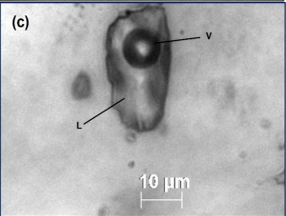Ore Forming Fluid of Epithermal Quartz Veins at Cisuru Prospect, Papandayan District, West Java, Indonesia
DOI:
https://doi.org/10.25299/jgeet.2019.4.3.2279Keywords:
Quartz Veins, Homogenization Temperature, Salinity, Paleo-depth, Epithermal High Sulfidation, Cisuru ProspectAbstract
The Cisuru area is located in Talegong Sub-district, Garut Regency, West Java, Indonesia which is belongs to the central part of Southern Mountain Slope. The aim of this research is to understand the nature and characteristic of fluid inclusion from quartz veins (especially drill core samples) in the study area. Rock units in the area are characterized by Tertiary volcanic rocks and volcaniclastic sequence which is mainly composed of andesite, andesitic breccia, volcanic breccia, lapilli tuff, dacite and related to the intrusion of diorite. The Cisuru epithermal mineralization is dominantly hosted by andesite, dacite, breccia and lapilli tuff, and would probably be controlled by both permeable rocks and NS and NE-SW trending strike-slip faults. The mineralization is shown as void filling and replacement within the silica zone, veinlets along with the open space/fractures and dissemination. Fluid inclusion from quartz veins was studied to know nature, characteristics and origin of hydrothermal fluids. Microthermometric measurements of fluid inclusions were realized by using a Linkam THMSG 600 combined freezing and heating stages. Homogenization temperature and final ice melting temperature were measured for primary two-phase inclusion from quartz veins. Base on the study of the fluid inclusion, the value of homogenization temperature (Th) range from 200 ºC to 395 °C and ice melting temperature range from -0.1 to - 4.5 where salinity range from 0.2 to 7.2 wt. % NaCl equivalent. Fluid inclusion petrography and microthermometric measurement data exhibit that fluid mixing, dilution and boiling were main processes during the hydrothermal evolution. The formation temperature of each quartz vein is 260 ºC to 290 ºC and also their formation depth is estimated between 560m to 925m respectively. Combination of fluid inclusions petrography, microthermometric measurement, and estimate paleo depth from Cisuru area were suggested under the epithermal environment.
Downloads
References
Alzwar, M., Akbar, N. and Bachri, S. 2004 Ge ological Map of the Garut and Pameungpeuk Quadrangle, Jawa, in:
Gafoer, S., Amin, T.C. and Simandjuntak, T.O. (eds.), Garut 1208-6 & Pameungpeuk 1208-3, Second edition. Geological Research and Development Centre, Bandung. Scale 1: 100.000Aspden, J.A., Stephenson, B., and
Cameron, N.R., 1982a, Tectonic map of northern Sumatra (1:500,000) British Geological Survey.
Bodnar, R.J. 1993. Revised equation and table for determining the freezing point depression of H2O-NaCl solution, Geochimica et Cosmochimica Acta 57: 683-684.
Bodnar, R.J., Reynolds, T.J., and Kuehn, C.A., 1985. Fluid inclusion systematic in epithermal systems: Reviews in Economic Geology, 2, 73–97.
Hamilton, W.H., 1979. Tectonics of the Indonesian region. U.S. Geological Survey Professional Paper, 1078, 345
Haas. J.L. Jr., 1971. The effect of salinity on the maximum thermal gradient of a hydrothermal system at hydrostatic pressure. Econ Geol. 66, 940–946.
Hatmanda. M, Geology and Characteristics of High-Sulfidation Epithermal Gold Deposits in Cijulang Prospect, Papandayan District, Garut, West Java. Thesis (MSc) (unpublished), 2013.
Roedder. E, 1984. “Fluid inclusions”, Mineral. Soc. Am. Rev. Mineral., vol. 12, no. Reviews in mineralogy.
Soeria-Atmadja, R., Suparka. S., Abdullah. C., Noeradi. D., and Sutanto, 1998. Magmatism in Western Indonesia, the trapping of the Sumba Block and the gateways to the east of Sundaland. Journal of Asia Earth Science, 16,1, 1-12.
Tun, M.M. 2015. Geology, Mineralogy, Geochemistry and Origin of Cijulang High sulfidation Epithermal Gold Prospect, West Java. Ph.D .Thesis.
Van Bemmelen, R.W., 1949, The Geology of Indonesia, V.F.A. Government Printing Office, The Hague, 732
Verdiansyah, O., Bangun, P., and Rahmat, I., 2012. High Sulfidation epithermal gold occurrences in Cijulang Area, Garut, West java. Proceeding of PIT IAGI Yogyakartar 2012, the 14 th IAGI Annual Convention and Exhibition.
Wilkinson, J.J., 2001. Fluid inclusions in hydrothermal ore deposits. Elsevier Science, Lithos 55 (2001), 229-272.

Downloads
Published
Issue
Section
License
Copyright @2019. This is an open-access article distributed under the terms of the Creative Commons Attribution-ShareAlike 4.0 International License which permits unrestricted use, distribution, and reproduction in any medium. Copyrights of all materials published in JGEET are freely available without charge to users or / institution. Users are allowed to read, download, copy, distribute, search, or link to full-text articles in this journal without asking by giving appropriate credit, provide a link to the license, and indicate if changes were made. All of the remix, transform, or build upon the material must distribute the contributions under the same license as the original.










